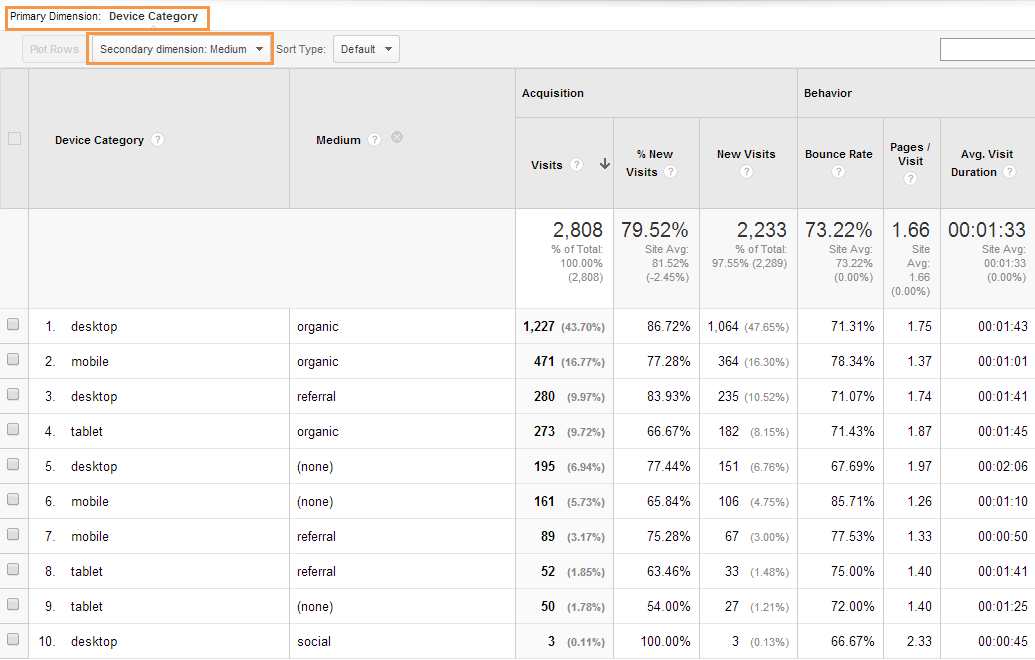Exactly How to Use Secondary Dimension in Google Analytics for Deeper Insights
Wiki Article
Enhance Your Information Analysis Using Secondary Dimension in Google Analytics
Discovering the capabilities of additional measurements in Google Analytics opens up a realm of opportunities for refining information analysis. By layering added dimensions onto key data sets, an even more detailed story arises, dropping light on individual interactions and efficiency indicators.Understanding Second Measurements
In the world of information analysis, a vital aspect to grasp is the concept of secondary dimensions and their importance in removing much deeper understandings from Google Analytics reports. Secondary dimensions in Google Analytics refer to extra criteria that can be contributed to the key dimension, permitting a more detailed analysis of information. By incorporating second dimensions, analysts can sector and filter information to discover patterns, patterns, and correlations that may not be obvious when considering the information as a whole. These secondary measurements can supply context and a more detailed understanding of individual habits, website traffic resources, and various other essential metrics tracked by Google Analytics.
Advantages of Making Use Of Second Measurements
When analyzing data in Google Analytics, the utilization of second measurements provides important understandings right into customer actions and performance metrics. By adding an additional dimension to your main information, you can dig deeper right into the attributes of your website site visitors and their interactions. One of the crucial benefits of using second dimensions is the capability to section and contrast information better. This segmentation allows you to recognize how various variables, such as demographics or website traffic resources, impact customer behavior and conversions (Secondary Dimension in Google Analytics).
Additionally, additional measurements boost the context of your main data, offering a much more thorough sight of customer engagement and performance metrics. On the whole, the usage of second dimensions in Google Analytics can dramatically improve the deepness and quality of your data analysis, leading to more informed decision-making and enhanced results.
How to Include Secondary Dimensions
By including secondary measurements in Google Analytics, customers can gain much deeper understandings into their data evaluation process, permitting for more detailed analysis of user behavior and efficiency metrics. Including secondary measurements is an uncomplicated process that can substantially boost the depth of analysis. Once in the report, situate the "Secondary measurement" tab over the information table.Studying Information With Second Dimensions
Utilizing second dimensions in data analysis offers an extra detailed understanding of customer habits and efficiency metrics. By adding a secondary dimension to your main data set in Google Analytics, you can delve deeper into the qualities of your web site site visitors and their communications. Integrating the key dimension of 'source/medium' with the secondary dimension of 'touchdown page' can reveal which details pages are drawing in website traffic from different sources, assisting you optimize these pages for much better involvement.
Basically, assessing information with additional dimensions encourages you to obtain useful understandings into user behavior, identify fads, and make informed choices to boost the efficiency of your electronic homes.
Best Practices for Second Dimensions
In data analysis, including secondary measurements effectively can substantially improve the deepness of understandings originated from metrics and user behavior patterns. When using additional dimensions in Google Analytics or any type of other logical device, it is essential to follow finest methods to ensure the precision and importance of the data analysis.One click now trick ideal technique is to carefully pick second measurements that enhance the primary measurement being analyzed. Choosing second dimensions that supply added context or additional segmentation can offer a much more detailed understanding of the information. It is also crucial to prevent overcomplicating the evaluation by including as well many additional dimensions, which may cause confusion or dilution of insights.
Furthermore, it is recommended to experiment with different combinations of primary and second dimensions to uncover new connections and patterns. Routinely improving the option and examining of additional dimensions based on the certain objectives of the evaluation can result in even more actionable insights. By adhering to these best practices, information experts can take advantage of secondary measurements efficiently to improve the general information analysis process and decision-making capacities.

Verdict
To conclude, including additional measurements in Google Analytics is essential for a thorough data evaluation approach. By leveraging additional dimensions alongside key ones, marketers and analysts can reveal valuable insights and correlations that can notify decision-making and maximize digital marketing approaches. Understanding exactly how to effectively make use of second measurements and following finest practices will certainly enable experts to remove significant information and enhance their general performance metrics.Second measurements in Google Analytics refer to added parameters that can be added to the primary dimension, enabling for a more thorough analysis of data. By incorporating second dimensions, analysts can section and filter data to uncover patterns, fads, and relationships that could not be noticeable when looking at the information as a check it out whole. Integrating the main dimension of 'source/medium' with the additional dimension of 'touchdown page' can reveal which details pages are drawing in traffic from various resources, helping you optimize these pages for far better interaction.
One key ideal technique her comment is here is to very carefully choose second measurements that enhance the main dimension being examined. By complying with these best practices, information experts can utilize additional dimensions efficiently to improve the general information evaluation procedure and decision-making capabilities.
Report this wiki page